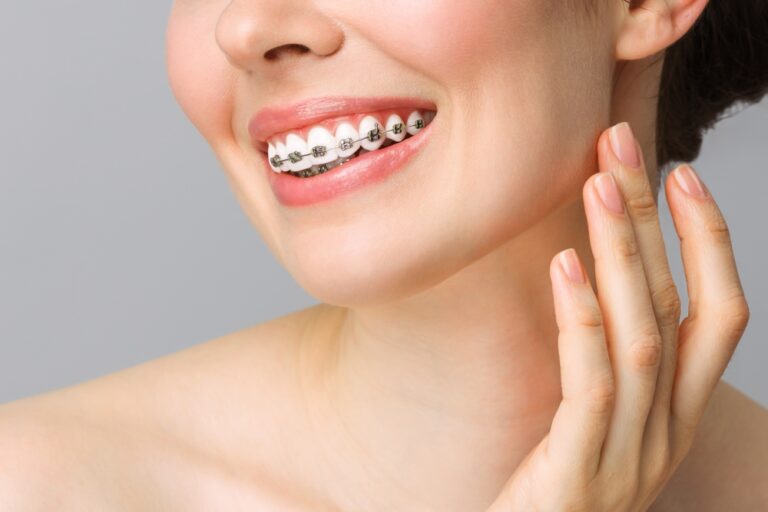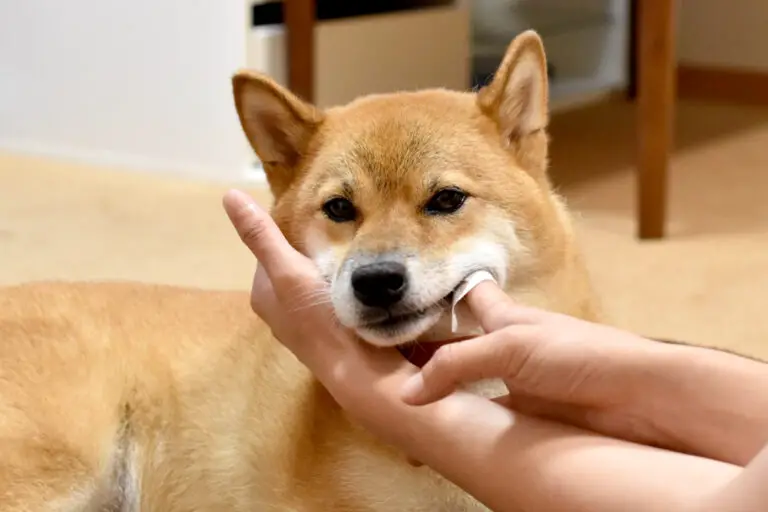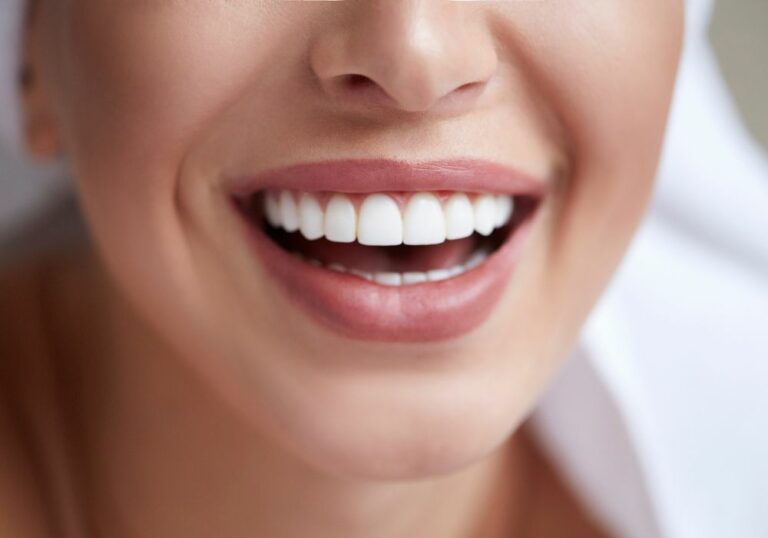Understanding the anatomy of a smile
When we smile, the muscles in our face contract to pull up the corners of our mouths. This movement is primarily controlled by the zygomatic major muscle, which originates from the cheekbone (zygomatic bone) and inserts into the corner of the mouth.
As this muscle contracts and our mouth widens into a smile, our upper lip is raised upward, exposing our upper teeth. Simultaneously, our lower lip is pulled downward and slightly relaxed, revealing our lower teeth as well.
In a full, broad smile, both the upper and lower teeth should be visible. However, some people find that only their lower teeth are exposed when they smile, while their upper teeth remain covered by the upper lip. There are several anatomical factors that can cause this phenomenon:
Small or retruded maxilla

The maxilla, or upper jaw, contains the upper teeth. If the maxilla is abnormally small or positioned too far back in the face (a condition called maxillary retrusion), this can limit how much the upper teeth are revealed when smiling.
Genetic factors like parental jaw size, developmental conditions like cleft palate, or childhood oral habits like thumb-sucking can all contribute to maxillary retrusion.
Large or protrusive mandible
Conversely, a disproportionately large or protrusive mandible (lower jaw) can make the lower teeth appear oversized and overly exposed in a smile while the upper teeth remain obscured and too far back.
The mandible may protrude due to genetic size, current or past orthodontic work, or conditions like TMJ dysfunction that alter bite position over time.
Short upper lip
Some individuals simply have a shorter upper lip in relation to their maxilla/teeth size. When they smile, their shorter lip lifts less compared to a longer upper lip, meaning fewer upper teeth show.
Certain ethnicities, like those of Asian descent, tend to statistically have shorter upper lips which predisposes them to showing less upper incisors on smiling.
Hyperactive lip elevator muscles
There are small muscles like levator labii superioris that connect the upper lip to the nose and control the upward lift of the upper lip. Some people have overactive contractions of these lip elevator muscles when smiling.
This causes the upper lip to raise too far upwards beyond the maxillary teeth, resulting in only the lower teeth being exposed while the upper teeth remain covered.
Excess upper gingival tissue
In some cases, an excessive amount of upper gum tissue overlies the maxillary front teeth. This is sometimes called a “gummy smile”. When smiling, the extra upper gum tissue is exposed instead of the teeth, again obscuring the upper incisors.
Combination of factors
Often it is a combination of the above anatomical factors that leads to only the lower teeth being visible when an individual smiles. For example, maxillary retrusion coupled with an overactive upper lip elevator would exacerbate the problem.
Impacts of only showing lower teeth when smiling

While mostly an aesthetic concern, having only lower teeth exposed on smiling can potentially have some functional and psychosocial impacts:
Aesthetic concerns
Showing an excessive amount of lower teeth and minimal upper teeth when smiling is often perceived as unaesthetic and awkward.
Our social ideals and standards of attractiveness tend to favor a smile where a balanced amount of the upper and lower teeth are revealed. Only seeing lower teeth violates this expected balance and symmetry, which can lead to self-consciousness about one’s smile.
People may feel their smile looks too “gummy”, “reverse”, or “all teeth and no lips” when the upper incisors are not exposed properly. This can cause reluctance to smile openly or fully.
Difficulty pronouncing some sounds
Having impaired visibility of one’s own upper teeth when speaking or smiling can also hinder proper enunciation of certain speech sounds that require precise lip shaping and tongue positioning against the upper incisors.
Sounds like the “f” and “v” fricative consonants are produced by shaping the lower lip against the upper teeth. Not being able to see one’s upper teeth clearly can lead to slight slurring or lisping of words containing these sounds.
Chewing and biting problems
Chewing, biting, incising ability can also suffer if the upper incisors are constantly obscured by the upper lip. Not being able to fully see your maxillary front teeth means not being able to accurately judge how they align with the mandibular teeth when closing the bite.
This reduced proprioceptive feedback when eating can allow more food to get stuck between the upper and lower teeth since their positioning is visually unclear. More difficulty cleanly biting into or incising certain foods can result.
Solutions for showing only lower teeth on smiling

If only revealing lower teeth when smiling is a concern, there are several potential solutions:
Orthognathic surgery
For severe jaw size mismatches or position discrepancies between the maxilla and mandible, orthognathic surgery may be recommended by an oral surgeon or orthodontist.
Procedures like LeFort I osteotomies and BSSO can reposition a retruded maxilla forward or reduce a protrusive mandible. This can dramatically improve tooth visibility and expose more maxillary incisors when smiling.
However, such surgeries have risks like nerve damage and long recovery periods, so should be very carefully weighed.
Botox injections
Injecting botulinum toxin (Botox) into the upper lip elevator muscles can prevent them from contracting too forcefully when smiling. This helps smooth out the elevation of the upper lip so more maxillary incisors remain visible instead of being obscured.
The muscle-paralyzing effects of Botox last roughly 3-4 months before needing to be repeated. Side effects are minimal in most cases, but some people dislike the sensation or costs of repeated injections.
Lip retraining exercises
For mild cases of hyperactive upper lip elevators, simple muscle retraining exercises can sometimes help the individual gain control over their smile animation.
Doing exercises like pulling down gently on the upper lip while smiling can teach those muscles over time to contract with reduced force and range of motion. Retraining the upper lip will take consistency and patience.
Dental veneers or bonding
Cosmetic dentistry like veneers or bonding applied to the maxillary front teeth can increase their apparent length and make more of them visible even when the upper lip is low. This enhances visibility without surgery.
However, altering healthy teeth solely for improved aesthetics does carry risks like nerve damage, tooth devitalization, and irreversible enamel removal that must be carefully weighed beforehand.
Coping with and embracing a low upper lip smile
For those who opt not to treat a smile that only reveals lower teeth, there are tips for learning to accept and embrace it:
- During video calls/photos, position camera from chest up to avoid seeing your own smile directly.
- Avoid wearing bold lipstick or gloss that further camouflages the upper lip movement.
- Use eye contact, humor, gesturing to draw attention away from the specifics of your smile.
- Remember many celebrities like Julia Roberts have similar low lip smiles.
- Recognize most people do not scrutinize or judge smiles as harshly as you perceive.
- Smile confidently and do not try to hide your smile, as this can seem expressionless and unfriendly.
Frequently Asked Questions
What causes only my lower teeth to show when I smile?
The most common causes are:
- Small upper jaw or protrusive lower jaw
- Short upper lip length
- Overactive upper lip elevator muscles
- Excess upper gum tissue covering teeth
Can this affect my oral health?
No direct effects on health are likely. But impaired visibility of the bite can allow more trapped food and plaque buildup. Speech changes are also possible.
At what age does this problem with tooth visibility tend to occur?
It can be present from early childhood if skeletal jaw discrepancies are involved. Later in life, gum recession and lip muscle changes can cause it to arise as well.
Can I permanently fix this myself without surgery?
Non-surgical approaches like Botox, lip exercises, veneers may help somewhat but cannot produce major change in tooth visibility alone. Surgery is needed for substantial increases in exposed upper teeth.
Should I just stop smiling to hide thisissue?
Avoiding smiling can seem unfriendly and expressionless. Try to smile naturally instead, as people will still find it warm and likeable, even if mainly lower teeth are visible.
Conclusion
Showing predominantly lower teeth when smiling is common and often multifactorial. Treatments should be approached cautiously after considering risks versus benefits. But self-acceptance is equally important, as a smile’s warmth stems from authenticity, not perfect anatomy.






